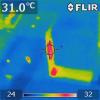To test the hypothesis, we detached the beam-dump and placed it for 10 minutes on the air-conditioning to let it cool down. After that, we re-installed it again, without unlocking the ITF. As shown in fig 3, this effectively reset the etalon-like modulation and around 20 fringes can be seen. It is thus very likely that the beam-dump is to blame. The exact mechanism of the etalon is not yet understood, but there might be some interference between 2 reflections inside the metal box or between one reflection in the beam-dump and the output window.
The optical path length change between 2 optical surfaces separated by 10 cm of aluminum is given by OPD = n_fringe * lambda / 2 = L * alpha * deltaT, where alpha is the thermal expansion coefficient of aluminum of 20e-6. Assuming a distance of 10 cm, a temperature increase of 2.6 degrees is required to explain the 10 fringes seen during a normal lock, which seems plausible. The effect of the dndT of air as given by Edlen's equation should be an order of magnitude lower.


